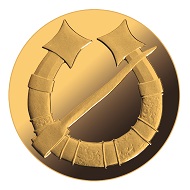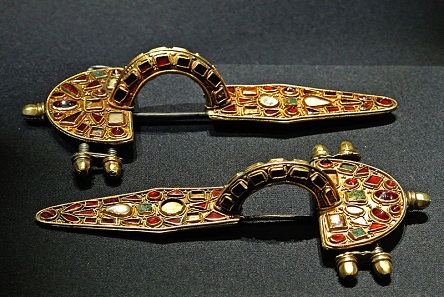September 28, 2017 – Latvijas Banka has issued a new 20 euro gold collector coin “Gold Brooches. The Horseshoe Fibula”. The coin replicating a horseshoe fibula continues the series of euro gold collector coins dedicated to Latvia’s centenary. In November 2016, a collector coin featuring a disc fibula was issued, but in 2018, the anniversary year, this series will be concluded with a golden collector coin replicating a bubble fibula.
Latvia / 20 Euros / Gold .9999 / 6g / 21mm / Design: Inguna Elere (graphic design) and Solvita Rulle (plaster model) / Mintage: 4000.
The graphic design of the collector coin “Gold Brooches. The Horseshoe Fibula” has been created by Inguna Elere, and the plaster model – by Solvita Rulle. Both artists are also the authors of the coin replicating the disc fibula.
The coin “Gold Brooches. The Horseshoe Fibula” has been minted by “Münze Österreich Aktiengesellschaft” (Austria). Inscriptions “#Latvija”, “#pakavsakta”, “#8_12gs”, “20 euro” and “#2017” are depicted on the obverse of the gold coin, while the reverse features a stylised image of a 12th century horseshoe fibula with star-shaped ends.
According to the concept of artist Inguna Elere, the brooch featured on the coin provides centuries-old information, while the hashtags highlighting the times we live in are located on the obverse of the coin. The brooch tells us a story about ancient times in Latvia’s history, but the reverse of the coin – about the present day, i.e. how we communicate in the virtual environment and social networks, and how we select topics important to us.
Two specimens with a particularly lavish decoration are these Germanic fibulae dating from the early 5th cent. AD, today in the Kunsthistorisches Museum Vienna. Photo: James Steakley / Wikimedia Commons / CC BY-SA 3.0.
The history of the brooch in the territory of Latvia began with various brooches from the early Iron Age (1st-4th century AD) – the so-called eye fibulae, tutulus fibulae, cross-ribbed fibulae, arbalest fibulae and round disc fibulae with openwork wheel, cross and fire cross motifs. The older brooches were imported, but soon the local craftsmen began to use them as models to make their own brooches, with their form reflecting the local aesthetic and mental concepts. Brooches were used to fasten and adorn clothing by all – men, women and children. The form of and ornamentation on brooches also served a protective function (jewellery as amulet). The form, size and material may have changed, yet the brooches have remained popular until the present day.
Horseshoe fibula was the most popular type of ancient brooches and has been used on the territory of contemporary Latvia for almost 1.000 years. They became a typical adornment in the Late Iron Age (9th-12th century) when they were cast in bronze, iron and silver. Horseshoe fibulae were used by both men and women. Only at the end of the 17th century horseshoe fibulae were completely replaced by ring fibulae.
The collector coin “Gold Brooches. The Horseshoe Fibula” is legal tender in the Republic of Latvia, yet the release of such coins in circulation is highly unlikely, as they are in fact works of art and are in special demand among coin collectors and other interested parties. The maximum mintage of the coin is limited to 4 000.
This is the website of Latvijas Banka.
On YouTube, you can watch a video on “Gold Brooches. The Horseshoe Fibula”.
And to learn more about its predecessor, “The Disc Fibula”, please click here.







